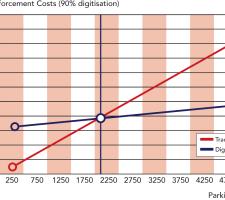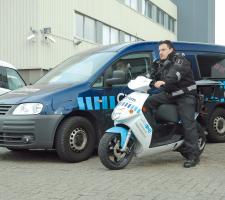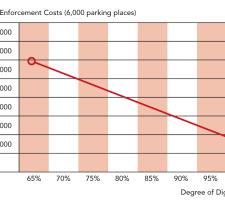
Amsterdam had taken the final step in digitising parking and parking enforcement and the move is paying dividends.
It was almost a decade ago that the City of Amsterdam decided to start the evolution - or maybe even a revolution – of its parking enforcement: it got rid of the paper parking permit or ticket behind the windscreen and introduced the digital parking right. It was the first step on a bumpy but successful road to digitization, resulting in a fore running position in on street parking enforcement.
The rationale behind the decision was two-fold: service improvement and safety. Firstly, the municipality wanted to improve the service to residents by enabling them to request a parking permit online. That meant it was no longer necessary to put the paper permit behind the windscreen as the parking right was stored in a database - a safe and fraud-proof solution.
The city has 160,000 paid parking bays with charges ranging €3 - €5/hr and in 2006 visiting motorist got the opportunity to pay via mobile phone, thus enabling paying per minute of the actual parking duration. In addition, the parking meters were modified to enable drivers to enter their license plate registration – meaning there was no need to display a parking ticket.
Smaller cities
Amsterdam’s parking model has proven to be extremely cost effective and remunerative but, in general, to work well the digital parking enforcement solution requires a minimum of 3,000 parking spaces in combination with a digitization rate of 85%.
However, smaller municipalities could also benefit from similar efficiency gains by digitising parking rights with automated scan processing and management by using a smart back office system.
Such is the efficiency of the enforcement process that smaller municipalities may only need a scan vehicle for a few hours a day and could share this, along with the back office platform, with a neighbouring town to realise gains similar to those in Amsterdam.
However, this digitisation of parking rights presented the enforcement organisation with an unforeseen challenge. Although it was a step towards increased service to the motorists, it was also a retrograde step in terms of enforcement efficiency.
Previously, enforcement officers on the street only had to look inside the windscreen and at the license plate to see if the ticket or permit was valid or not. This way, 100 cars per hour could easily be checked. But now, with the invisible digital rights, to check if a car was legitimately parked the enforcement officer had to enter the license plate number manually in the PDA - a much more time consuming task. ”We noticed a productivity drop of 40%”, says Jørgen Weekes CEO of enforcement organisation Cition.
Enforcement efficiency
The solution was found in 2008 by implementing a technical innovation: a scan car that can read an average of 1,000 license plates per hour. This was an enormous boost in efficiency and productivity, especially since the scans were processed and managed automatically byAs the use of a scan car has intensified the enforcement level dramatically, there was an additional benefit: the parking and payment behaviour changed. Although at the beginning there was an increase in parking fines, after the first month, non-paying and overstaying motorists realised that the chances of being fined were so high that they either payed to park or stopped parking in paid areas.
There is another factor that impacts the efficiency of the enforcement process. In 2008, the City of Amsterdam started out with one scan car, but nowadays it deploys 10 scan cars and 3 scan scooters.
To get the highest return on the investment in these resources - both equipment and team members - it is essential to know where and how to enforce to ensure these resources are deployed in areas where they are most effective and urgent, and for as many hours as possible. The authorities in Amsterdam started to use the Planman workforce planning tool to organise the daily schedules in a way that enforcement could be done in the right place, at the right time.
This process optimisation enabled the organisation to do more with fewer resources and counted for another substantial decrease in costs. The costs of enforcement personnel dropped by 38% in five years.
And another effect was that due to the higher intensity of enforcement, the pay rate went up. Planman was developed using the parking data the City had generated along the way and that were presented by means of an intelligent reporting tool, Infoman. It resulted in a detailed insight into the parking and pay behaviour (occupancy and pay rate) across the paid parking area down to street segment level. This was important management input for assembling the enforcement teams and for further process optimisation.
Furthermore, Infoman gave a clear insight into the productivity and outcome of the enforcement process, the extent to which the objectives were being met and how further improvement could be achieved. And the parking data provided the parking management and policy makers with valuable information for sustainable parking and mobility policy strategies.
Decreasing costs
Initially in 2008, around 80% of Amsterdam’s parking rights were digitized and in 2014 this moved to 100%, resulting in huge increases in terms of efficiency gain.Having started on the road to digitize parking it became clear that relatively small increases in digitization rate means a huge step in efficiency. For instance: with a digitization rate of 85%, 85 out of every 100 parking rights is stored in a database. The remaining 15 have non-digital parking permits and rights (such as disabled and elderly people) and these will require an on-street check by an enforcement officer.
If the parking rights rate goes up to 86% then only 14 out of 100 cars needs checking, resulting in (1/15) 7% fewer follow-up actions and if that further increases to 90%, only 10 instead of the original 15 out of 100 cars needs to be checked, so that’s 33,3% less follow-up.
Remote enforcement
Having completed the digitisation of its parking rights 2014, this paved the way for a new and very efficient enforcement method in the city Amsterdam by using a Desk Force in a control room. This was implemented at the end of 2015. Theoretically, on-street enforcement is no longer needed as an enforcement officer can check the license plate information and the overview photos on-screen. This means another efficiency gain since it decreases follow-up actions by another 90%. In practice, municipalities might prefer to keep enforcement officers active on-street, for instance for broader than only parking enforcement purposes alone.Amsterdam has retained on-street officers to enforce the parking of foreign cars as, for legal reasons, the city cannot send the fine directly to the owner’s postal address. Instead the officers affix windscreen stickers containing information about payment the fine.
In conclusion Weekes says: “In the last 5 years, the revenue of paying visitors increased from €99m to €128m in 2015, an increase of around 30%. At the same time the personnel costs have decreased by 38%.”
RUC in the US: roles for CBA
The International Benefits, Evaluation and Costs (
FAST, the 2015 Fixing America’s Surface Transportation Act, provides funding for states to demonstrate user fee-based revenue mechanisms to maintain the long-term solvency of the US Highway Trust Fund - which administers federal fuel taxes.
A number of US states are preparing one or more proposals with planned start dates in 2016. There is no bar to heavy vehicle tests, or to pilots combining light and heavy vehicle tests. Collectively these will provide for costs and benefits evaluation in comparisons between future RUC revenues and current fuel taxes.
The RUC pilots are likely include in-depth analyses, similar to California’s planned independent viability test, while Oregon’s scheme is now permanently operational, with no legislatively-mandated stop date. CBA analyses of such studies will contribute to a better understanding of the benefits of transitioning from fuel taxes to more sustainable sources of revenue.
With the US vehicle fleet becoming more fuel efficient (to meet US Corporate Average Fuel Economy standards), recent projects and forecasts all point to a continuing decline of future fuel tax revenues. The surprise has been the increased pace of decline being predicted.
Based on numerous studies, Morello believes it is imperative for major public education campaigns to run alongside pilot projects.














